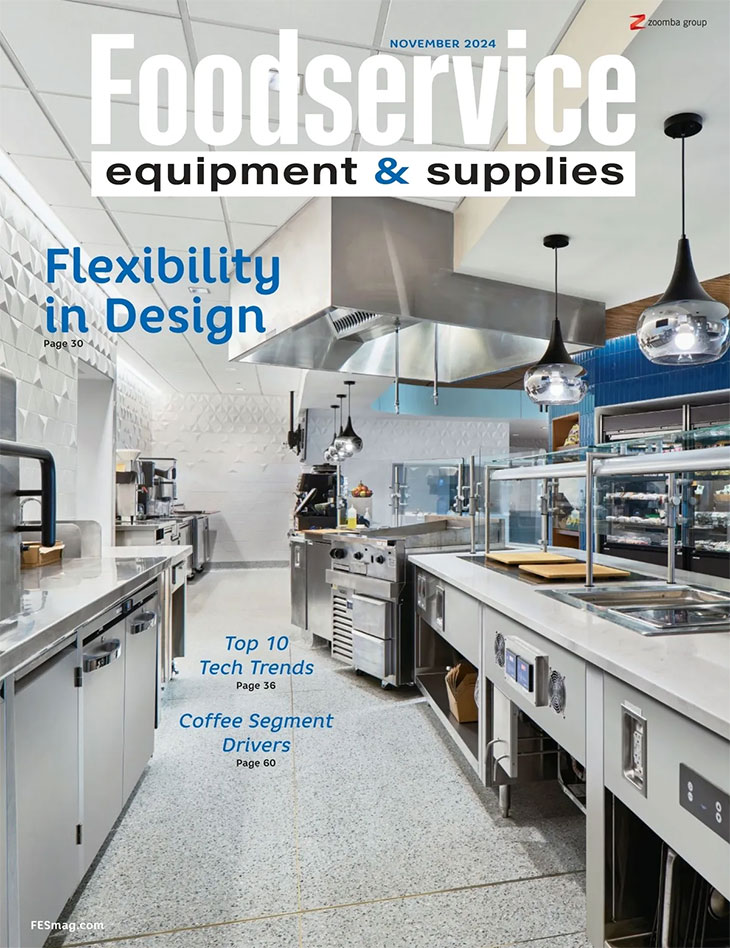Foodservice operators can choose from a variety of options for temperature control and monitoring in commercial kitchens. These include thermometers, wireless monitoring systems and handheld devices. The application will dictate the best monitoring method.
Temperature control devices play an integral role in any commercial kitchen’s food safety efforts. These instruments work with ovens, grills, fryers, refrigerators and freezers. Operators can use the various devices to ensure foods reach or remain at food-safe temperatures.
HACCP dictates food items, whether being delivered or stored, remain at 41 degrees F or less for refrigerated foods and 0 degrees F or less for frozen foods. Refrigerated cold foods in pantries and on buffets should be at 41 degrees F or less.
Hot food in buffets or steam tables requires holding temperatures of 140 degrees F or higher. Individual potentially hazardous food or time-temperature control for food safety (TCS/PHF) foods must each hold designated minimal internal temperatures of 140 degrees F or higher for 15 seconds.
With food reheating, temperatures must reach 165 degrees F or higher within two hours and be held for 15 seconds, then held hot at 140 degrees F until service.
Thermometers typically feature stainless-steel construction, with various temperature dial or display sizes. This tool is categorized by type, including thermocouple, thermistor, bimetal, infrared and digital probe, as well as use, such as oven and grill, refrigerator/freezer/air, beverage and frothing, candy and deep fry.
Bimetal or dial types of thermometers are designed to be left in the oven, while others are not. Bimetal thermometer sensors are constructed of two different metals bonded together. When heated, the combination will bend because one metal expands faster than the other. A pointer attaches to the free end, and the temperature registers on the dial beneath the pointer. These thermometers are durable, inexpensive and recalibratable, but they take longer to record temperatures since they have to be inserted past the top of the bimetal coil for accurate measurement.
Glass column thermometers have food-safe fluid sealed in a glass or plastic tube. A bulb at the column base contains fluid and expands or contracts as the temperature changes. A temperature scale is printed on or near the column, and the temperature is read from the scale. This type is economical and easy to use, but glass is subject to breaking. Also, the use of induction cooktops can interfere with the accuracy of these thermometers.
Thermocouple digital thermometers provide the quickest results, showing temperature readings in about two seconds. This type has a thin probe and is most often used to check final cooking temperatures in meat. The thermometer has two different metal wires joined together at one end and connects to a voltage measuring device at the other. When the thermometer is heated or cooled, a voltage is created that can be correlated to temperature. A variety of metal combinations or calibrations are available. These thermometers are more expensive but provide high accuracy and high temperature ranges, with quick readings and the ability for recalibration.
Thermocouple digital thermometers use infrared light rays to quickly measure the surface temperature of an item without touching it. Not only do the thermometers provide temperature readings for food, but they also eliminate the possibility of cross-contamination with temperature monitoring since no contact is made.
The most popular digital thermometer style includes a thermistor, which is a tiny thermally sensitive object located in the thermometer’s tip. A change in electrical resistance takes place with temperature variances, and resistance is measured by the passing of a direct current and production of a voltage drop. Although less expensive than digital thermocouple thermometers, the speed of response is comparable.
Technologically advanced wireless monitoring systems protect inventory and help verify equipment works correctly by automatically measuring critical metrics, such as temperature and humidity. These systems can monitor equipment such as walk-ins, freezers, dish machines, hot holding boxes and dry storage rooms to help ensure food quality and safety. If readings fall outside of preset limits, notifications can be sent to the appropriate people.
Handheld devices combine sophisticated software with a traditional thermocouple instrument to collect, track and store food temperature data. Some models also allow users to walk through procedural checklists. These handheld devices can make adhering to HACCP guidelines less cumbersome. When temperature or a checklist item is out of the user’s designated range, many of today’s models will prompt operators to take corrective action, all of which is documented for later viewing and analysis via the accompanying software.
Temperature logging devices collect temperature data while sensitive inventory is in transit. Typically used with stationary equipment and meal delivery carts, these small, battery-operated data loggers document environmental data. When the shipment arrives at its destination, the data logger is connected to a PC that displays the data. This ensures proper temperatures were maintained throughout transit.
Bluetooth technology allows remote control and monitoring of time, temperature and other attributes.












